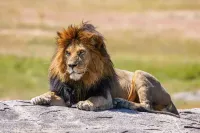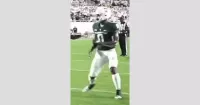The Bronx Zoo, located within Bronx Park in New York City, is one of the largest zoos in the U.S., covering 265 acres with naturalistic habitats divided by the Bronx River. Attracting approximately 2.1 million visitors annually, it's notable for its original Beaux-Arts buildings, particularly Astor Court, and the Rainey Memorial Gates, a 1934 sculpture by Paul Manship listed on the National Register of Historic Places.
1901: Monkey House Opening
In 1901, the Monkey House, originally named the Primate House, first opened at the Bronx Zoo.
December 17, 1902: Bronx Zoo obtains first Thylacine
On December 17, 1902, the Bronx Zoo became one of the few zoos outside of Australia, and one of only two in the United States, to hold a Thylacine, acquiring a male from German animal dealer Carl Hagenbeck.
1902: Rockefeller Fountain bought by William Rockefeller
In 1902, William Rockefeller bought the Rockefeller Fountain from Como, Italy, for lire 3,500.
1902: Jaguar escapes from cage
In 1902, a seven-month-old male jaguar broke out of his cage and escaped at the Bronx Zoo.
May 1903: Barbary lion cubs born
In May 1903, a pair of Barbary lions, Bedouin Maid and Sultan, produced three cubs, the first to be born at the Bronx Zoo.
1903: Bronx Zoo exhibits snow leopards
In 1903, the Bronx Zoo became the first U.S. zoo to exhibit snow leopards.
1903: Lion House opens
In 1903, the Lion House opened at the Bronx Zoo; it was later converted into the Madagascar! exhibit.
1903: Rockefeller Fountain Installed at the Zoo
In 1903, the Rockefeller Fountain was installed at the Bronx Zoo.
October 7, 1905: Sultan portrait painted by Charles R. Knight
On October 7, 1905, Charles R. Knight painted a portrait of Sultan, a Barbary lion, which became the focus of many of the zoo's postcards and the model for the lion atop the Rainey Memorial Gates.
1905: American Bison Society created
In 1905, the American Bison Society was created at the Bronx Zoo to save the American bison from extinction.
1905: Creation of the American Bison Society
In 1905, the zoo's first director, William T. Hornaday, along with President Theodore Roosevelt and other conservationists, created the American Bison Society (ABS) in an attempt to save the American bison from extinction.
September 8, 1906: Ota Benga Exhibited in the Monkey House
On September 8, 1906, visitors found Ota Benga in the Monkey House exhibit, alongside an orangutan named Dohong, marking the first day of his exhibition at the Bronx Zoo.
1906: Ota Benga's Exhibition
In 1906, Ota Benga, a man from the Mbuti pygmy ethnic group, was displayed as an exhibit at the Bronx Zoo. He spent time in the Monkey House, encouraged to hang his hammock and shoot his bow and arrow at a target.
October 11, 1907: First reintroduction of bison began
On October 11, 1907, the first reintroduction of bison began when the zoo sent six males and nine females, by rail, to the Wichita Mountains Wildlife Refuge in Oklahoma. Seven days later, the animals were successfully reintroduced to the park.
August 15, 1908: First Thylacine Dies
On August 15, 1908, the first male Thylacine obtained by the Bronx Zoo died.
1908: Zoo Center built
In 1908, the Zoo Center, a one-story Beaux-Arts building, was built in Astor Court at the Bronx Zoo.
January 1910: Relocation to Lynchburg, Virginia
In January 1910, Ota Benga was relocated to Lynchburg, Virginia, where he lived with the family of Gregory W. Hayes and received tutoring from Harlem Renaissance poet Anne Spencer.
January 26, 1912: Bronx Zoo receives second Thylacine
On January 26, 1912, the Bronx Zoo received a second male Thylacine from the Beaumaris Zoo in Tasmania.
November 7, 1916: Bronx Zoo receives third Thylacine
On November 7, 1916, the Bronx Zoo received an unsexed Thylacine in poor condition from Sydney animal dealer Ellis S. Joseph.
1916: Ota Benga's Suicide
In 1916, Ota Benga committed suicide at the age of 32.
1916: Animal hospital built
In 1916, the Bronx Zoo built the world's first animal hospital located at a zoo.
July 14, 1917: Bronx Zoo receives final Thylacine
On July 14, 1917, the Bronx Zoo received its final Thylacine, a female purchased from the Beaumaris Zoo by Joseph for £25 and resold to the zoo.
September 13, 1919: Thylacine Died
On September 13, 1919, the last Thylacine at the Bronx Zoo died.
1926: Shoebills Exhibited
In 1926, the Bronx Zoo and the Smithsonian Institution's National Zoological Park simultaneously became the first in the country to exhibit shoebills.
1934: Rainey Memorial Gates designed
In 1934, sculptor Paul Manship designed the Rainey Memorial Gates for the Bronx Zoo.
1935: Disbandment of the American Bison Society
By 1935, the American Bison Society, who had successfully carried out several more reintroductions from bison kept in zoos and ranches, considered their work done and disbanded that year.
1937: Okapi Exhibited
In 1937, the Bronx Zoo became the first in North America to exhibit okapi.
1941: African Plains Exhibit Opens
In 1941, the African Plains exhibit originally opened and was the first in the country to allow visitors to view predators and their prey in a naturalistic setting.
1941: Original Children's Zoo Opening
In 1941, the original Children's Zoo opened at the Bronx Zoo, featuring a nursery-rhyme theme.
1942: Rocking Stone Restaurant demolished
In 1942, the zoo's Rocking Stone Restaurant was demolished to make way for the World of Darkness exhibit.
July 1957: Platypus Penelope disappears
In July 1957, Penelope, a platypus at the Bronx Zoo, disappeared, abandoning her mate, Cecil. Zookeepers searched for her but found no evidence of her whereabouts.
1957: James's flamingo not extinct
In 1957, the James's flamingo was thought to be extinct until 1957.
1960: James's flamingo exhibited
In 1960, the Bronx Zoo became the first in the world to keep a James's flamingo, a species which had been thought to be extinct until 1957.
April 26, 1963: The Most Dangerous Animal in the World exhibit debut
On April 26, 1963, The Most Dangerous Animal in the World exhibit debuted at the Bronx Zoo's Great Apes House, featuring a statement about the danger humans pose.
September 24, 1964: Aquatic Bird House opens
On September 24, 1964, the current Aquatic Bird House opened at the Bronx Zoo, built on the foundation of the original house.
1966: Failed landmark designation attempt
In 1966, a previous attempt to designate Astor Court's buildings as a city landmark failed.
1968: Rockefeller Fountain Designated a New York City Landmark
In 1968, the Rockefeller Fountain was designated an official New York City landmark.
1969: World of Darkness opens
In 1969, the World of Darkness exhibit opened at the Bronx Zoo as the world's first major exhibit designed to introduce the public to nocturnal animals.
1971: Bison Range renovation
The Bison Range, a feature of the Bronx Zoo since its opening, was renovated in 1971.
1972: Rainey Memorial Gates Listed on National Register of Historic Places
In 1972, the Rainey Memorial Gates were listed on the National Register of Historic Places.
1972: World of Birds opens
In 1972, the World of Birds exhibit originally opened at the Bronx Zoo.
1976: Proboscis monkeys at Bronx Zoo
In 1976, the Bronx Zoo reported having eight proboscis monkeys, seven of which were born at the zoo.
1977: JungleWorld Planning Started
In 1977, planning for JungleWorld, located in the southeastern Wild Asia portion of the Bronx Zoo, was started.
1977: Monorail Inaugurated
In 1977, the monorail was inaugurated with the rest of the Wild Asia section of the Bronx Zoo.
1977: Arrival of Grumpy and Happy
In 1977, two female Indian elephants, Grumpy and Happy, were brought to the Bronx Zoo. They were captured as calves in Thailand and named after the Seven Dwarfs from Snow White.
1981: "The Most Dangerous Animal in the World" exhibit was still at the zoo
In 1981, "The Most Dangerous Animal in the World" exhibit featuring a mirror behind bars was reportedly still at the Bronx Zoo.
1981: New Children's Zoo Opening
In 1981, a new Children's Zoo opened at the Bronx Zoo, and was instantly successful.
1981: Gaur embryo implantation
In 1981, the Bronx Zoo successfully implanted a gaur embryo into a Holstein cow in an attempt to clone the endangered species.
June 1985: JungleWorld Completed
In June 1985, JungleWorld in the Bronx Zoo was completed at a cost of $9.5 million.
July 29, 1985: Death of animal keeper
On July 29, 1985, 24-year-old animal keeper Robin Silverman was killed by two female Siberian tigers after she entered their enclosure with a volunteer aide, marking the first and only human fatality in the zoo's history.
June 27, 1986: Himalayan Highlands Opens
On June 27, 1986, Himalayan Highlands exhibit opened at the Bronx Zoo, recreating the Himalayas region of Asia.
1989: Rapunzel was rescued
In 1989, Rapunzel was born in the wild in Sumatra and rescued from an area of rainforest that was slated to be cleared for a palm oil plantation.
June 6, 1990: Rapunzel the Sumatran rhinoceros
On June 6, 1990, the Bronx Zoo received a female Sumatran rhinoceros named Rapunzel and was one of only three zoos in North America to hold the critically endangered species.
1990: Canada goose pest problem
In 1990, the Bronx Zoo experienced a pest problem with Canada geese, leading to the hiring of a sharpshooter and the destruction of eggs to decrease their numbers.
1990: Gelada Reserve Opens
In 1990, the Gelada Reserve, originally called Baboon Reserve, opened at the Bronx Zoo. It was the largest primate exhibit in the United States at the time.
1991: Baboon Reserve wins AZA Exhibit Award
In 1991, the Baboon Reserve at the Bronx Zoo won the AZA Exhibit Award.
1991: Sterilization of Canada geese
In 1991, the Bronx Zoo employed a gentler method of sterilizing the Canada geese to control their population.
February 1995: De Jur Aviary collapses
In February 1995, the Bronx Zoo's De Jur Aviary collapsed during a snowstorm, resulting in the loss of about 30 seabirds, including Inca terns and gulls.
1995: Grizzly bears at the zoo
In 1995, the two rescued grizzly bears sent to the Central Park Zoo in 2015, had been at the Bronx Zoo.
1996: Indoor Butterfly Conservatory Inaugurated
In mid-1996, the indoor butterfly conservatory was built and inaugurated. The attraction is a 170-foot-long maze with a greenhouse in the middle hosting 44 species and over 1,000 butterflies.
May 17, 1997: Russell B. Aitken Sea Bird Aviary opens
On May 17, 1997, the Russell B. Aitken Sea Bird Aviary opened at the Bronx Zoo, designed to resemble the Patagonian coast.
September 1997: Oklahoma City Zoo offer
In September 1997, the Oklahoma City Zoo would have purchased the butterfly conservatory if it was not successful.
March 1999: Last Proboscis monkeys in US
As of March 1999, the Bronx Zoo only had two proboscis monkeys left, these two being the last members of their species kept in the United States.
1999: Congo Gorilla Forest Opening
In 1999, the Congo Gorilla Forest opened at the Bronx Zoo.
2000: Zoo's money spent on pandas
A study published by The Washington Post in 2005 found that the four U.S. zoos holding pandas had spent $33 million more on their animals than revenue made off of them between 2000 and 2003.
2000: Rapunzel returned to the zoo
In 2000, Rapunzel was returned to the zoo after being brought out for breeding purposes.
2000: Astor Court Designated as Landmark
In 2000, the New York City Landmarks Preservation Commission designated Astor Court's buildings as a city landmark.
2000: Zoo Center landmarked
In 2000, the Zoo Center building at the Bronx Zoo was landmarked.
2001: Addition of Javan langurs to JungleWorld
In 2001, a troop of Javan langurs was added to JungleWorld at the Bronx Zoo, sharing an enclosure with Asian small-clawed otters.
July 2002: Failed introduction of elephants
In July 2002, the Bronx Zoo attempted to mix Grumpy and Happy with Patty and Maxine. However, the introduction failed when Patty and Maxine attacked Grumpy, resulting in injuries.
May 15, 2003: Tiger Mountain opens
On May 15, 2003, Tiger Mountain opened at the Bronx Zoo as a three-acre exhibit for Amur and Malayan tigers.
2003: Zoo's money spent on pandas
A study published by The Washington Post in 2005 found that the four U.S. zoos holding pandas had spent $33 million more on their animals than revenue made off of them between 2000 and 2003.
2003: Wolf Wood becomes Tiger Mountain
Before the opening of Tiger Mountain in 2003, the area was once Wolf Wood, and included a pack of wolves.
2003: Proboscis monkeys sent to Singapore Zoo
In 2003, the Bronx Zoo sent its pair of proboscis monkeys to the Singapore Zoo.
2004: Mitsubishi Riverwalk Opening
In 2004, the Mitsubishi Riverwalk opened after the completion of a cleanup project on the Bronx River. The walkway was funded by Mitsubishi International Corporation Foundation.
2004: Tiger Mountain wins AZA Exhibit Award
In 2004, the Tiger Mountain exhibit at the Bronx Zoo won the AZA Exhibit Award.
December 2005: Death of Rapunzel
In December 2005, Rapunzel the Sumatran rhinoceros died in her 30s at the Bronx Zoo.
2005: The Washington Post study
A study published by The Washington Post in 2005 found that the four U.S. zoos holding pandas had spent $33 million more on their animals than revenue made off of them between 2000 and 2003.
2005: Sumatran rhino Rapunzel dies
In 2005, Rapunzel, one of the few Sumatran rhinos held in U.S. zoos, died at the Bronx Zoo.
2005: Sperm sent to Cincinnati Zoo
In 2005, the Bronx Zoo sent the frozen sperm of a male Indian rhinoceros to the Cincinnati Zoo for artificial insemination purposes.
2005: Bug Carousel installed
In 2005, the Bug Carousel with seats shaped like insects was installed at the Bronx Zoo.
2005: Resurrection of the American Bison Society
In 2005, the Wildlife Conservation Society resurrected and re-purposed the American Bison Society to help build the social and scientific foundations for the ecological restoration of bison.
August 2006: Adoption of snow leopard cub Leo
In August 2006, the Bronx Zoo adopted an orphaned 13-month-old snow leopard cub named Leo, who was rescued from Pakistan after a landslide killed his mother.
November 2006: Eco-friendly restrooms opened
In November 2006, the Bronx Zoo opened brand-new eco-friendly restrooms outside the Bronx River Gate, featuring composting toilets.
2006: Snow leopard Leo brought to zoo
In 2006, the Bronx Zoo brought in a male snow leopard named Leo from Pakistan after he was orphaned at around two months old.
2006: Sammy euthanized
In early 2006, Sammy, a younger female elephant at the Bronx Zoo and companion to Happy, developed severe liver disease and was euthanized.
March 2007: Joint program announced
In March 2007, the Wildlife Conservation Society and the Fordham University Graduate School of Education announced a joint program for a Master of Science degree in education and New York State initial teacher certification in adolescent science education (biology, grades 7–12).
June 2007: Otters kill langur in JungleWorld
In June 2007, a romp of otters grabbed a langur near the water in JungleWorld and proceeded to maul and drown it in full view of visitors. A zookeeper attempted to intervene, but was unsuccessful, and the incident was recorded and uploaded to YouTube.
2007: Chinese alligators reintroduced into the wild
In 2007, the Bronx Zoo successfully reintroduced three Chinese alligators into the wild as part of a 10-year effort to reintroduce the species to the Yangtze River in China.
2007: Monorail Refurbishment
In 2007, the monorail at the Bronx Zoo was refurbished.
April 2008: First Run for the Wild event
In April 2008, the Bronx Zoo hosted the first Run for the Wild event, a 5k run organized by the Wildlife Conservation Society to raise money and awareness for conservation programs.
June 2008: Amazing Amphibians Exhibition Opening
In June 2008, the Amazing Amphibians exhibition opened in the Bronx Zoo's Zoo Center.
June 20, 2008: Madagascar! exhibit opens
On June 20, 2008, the Madagascar! exhibit opened at the Bronx Zoo, recreating various habitats found on the island of Madagascar.
July 8, 2008: Skyfari Derailment
On July 8, 2008, high winds and heat led to one of the Skyfari cars derailing at the Bronx Zoo, trapping thirty-six passengers for up to five hours.
2008: Grizzly bear born in Glacier National Park
In 2008 a fourth cub, a grizzly bear born in 2008, was rescued from Glacier National Park in Montana and named Glacier after the park. In January 2010, the Bronx Zoo adopted the cub.
2008: Male bald eagle found
In 2008, a 5-year-old male bald eagle was found in Wyoming. In February 2011, the Bronx Zoo took in the bird.
2008: Lion House Reopened
In 2008, the former Lion House in Astor Court was reopened as the "Madagascar!" exhibit.
January 2009: Skyfari Permanent Closure
In January 2009, the Skyfari at the Bronx Zoo was permanently closed after 35 years of operation, due to budget cuts and maintenance costs.
June 2009: Aardvarks join exhibit
In June 2009, two aardvarks imported from Tanzania joined the Carter Giraffe Building exhibit at the Bronx Zoo.
July 2009: Reintroduced alligators breeding naturally in the wild
In July 2009, the Bronx Zoo announced that the Chinese alligators they had reintroduced into the wild had begun breeding naturally, producing 15 hatchlings. This milestone marked a significant success in the zoo's 10-year effort to reintroduce the species to the Yangtze River in China.
2009: Bronx Zoo yearly visitors
As of 2009, the Bronx Zoo had an average of 2.1 million yearly visitors.
2009: Congo Gorilla Forest Visitation Milestone
As of 2009, the Congo Gorilla Forest at the Bronx Zoo had been visited 7,000,000 times.
2009: Three bear cubs were siblings born
In 2009 three of the bears adopted by the Bronx Zoo in January 2010, two males and one female, were siblings born in 2009 and rescued from the ABC Islands in Alaska
2009: Budget Cuts
In 2009, New York City cut funding for the state's zoos, aquariums, and botanical gardens, leading to staff reductions and the closure of four sections of the Bronx Zoo.
2009: Arabian oryx and blesbok phased out
In 2009, the Arabian oryx and blesbok were phased out of the African Plains exhibit at the Bronx Zoo due to budget cuts and low visitor interest. This section was replaced by the Nature Trek.
2009: Run for gorillas
In 2009, the Bronx Zoo's annual run focused on gorillas to raise funds for their protection.
2009: Rare Animal Range Closure
In 2009, the Rare Animal Range at the Bronx Zoo was forced to close due to budget cuts and unpopularity of many of the species.
2009: World of Darkness closes
In 2009, the World of Darkness exhibit at the Bronx Zoo closed due to budget cuts and the high cost of running the exhibit.
2009: Thawing and use of sperm
In 2009, the frozen sperm from the Bronx Zoo's male Indian rhinoceros was thawed out at the Cincinnati Zoo and used in artificial insemination.
2009: Turacos raise chicks
In mid-2009, the Bronx Zoo's hand-reared pair of great blue turacos successfully raised chicks, the first known instance of a hand-reared pair doing so.
January 2010: Lion cubs born
In January 2010, the Bronx Zoo had one male and two female lion cubs born.
April 2010: Lion cub naming contest
In April 2010, the lion cubs made their public debut after the zoo, in partnership with the New York Daily News, held a contest to name them, the winning names were Shani, Nala, and Adamma.
September 2010: Aardvark born at zoo
In September 2010, the aardvark pair at the Bronx Zoo gave birth to a male named Hoover, marking the first aardvark birth at the zoo.
2010: Bronx Zoo animal population
As of 2010, the Bronx Zoo is home to more than 4,000 animals of 650 species.
2010: Tigers bred at zoo
In 2010, the Bronx Zoo successfully bred both Amur and Malayan tigers.
2010: Run focused on tigers
In 2010, the Bronx Zoo's annual run focused on tigers to raise funds for their protection.
2010: Relocation of otters
In 2010, the otters at the Bronx Zoo were relocated into two exhibits, one at the Children's Zoo and another in JungleWorld.
2010: Birth of a calf
In late 2010, the Cincinnati Zoo successfully artificially inseminated a rhino using sperm from the Bronx Zoo's male Indian rhinoceros. The calf, unfortunately, did not survive long-term.
2010: World of Birds closes for repairs
In the summer of 2010, the World of Birds exhibit at the Bronx Zoo closed for repairs and upgrades.
February 2011: Bald eagles rescued
In February 2011, the Bronx Zoo received two bald eagles that had been rescued in Wyoming.
March 25, 2011: Egyptian cobra escapes
On March 25, 2011, an Egyptian cobra escaped from its off-show enclosure at the Bronx Zoo's World of Reptiles, leading to the exhibit's closure to the public.
March 26, 2011: Closure of World of Reptiles after cobra goes missing
On March 26, 2011, the Bronx Zoo announced that the World of Reptiles exhibit was closed after a venomous adolescent cobra was discovered missing from its off-exhibit enclosure on March 25. The incident sparked a popular Twitter parody account.
May 9, 2011: Green peafowl escapes
On May 9, 2011, a female green peafowl escaped from the Bronx Zoo before being caught on May 11.
September 11, 2011: Lesser kudu escapes enclosure
On September 11, 2011, a lesser kudu escaped from its enclosure at the Bronx Zoo for about half an hour and then returned to its enclosure once a zoo worker opened the gate.
2011: Run to protect the Punta Tombo peninsula of Argentina for Magellanic penguins
In 2011, the Bronx Zoo's annual run helped raise funds to protect the Punta Tombo peninsula of Argentina for Magellanic penguins.
2011: Run for the Wild event for sea turtles
In 2011, the New York Aquarium, another WCS institute, held its own Run for the Wild event for sea turtles in early October. The 5k run began at the aquarium and led down the Riegelmann Boardwalk on Coney Island.
2011: WCS arranged for a herd of female bison
In the fall of 2011, the WCS arranged for a herd of female bison originating from the American Prairie Reserve to be sent to the Colorado State University's Animal Reproduction & Biotechnology Laboratory to be used as surrogates in an attempt to transfer the fertilized embryos of genetically pure bison.
February 2012: Monkey House Closure
In late February 2012, the Monkey House at the Bronx Zoo closed after 111 years of operation.
June 20, 2012: Birth of genetically pure bison calf
On June 20, 2012, a genetically pure bison calf was born at the Bronx Zoo after a surrogate hybrid bison carried the embryo.
December 2012: Birth of Chinese yellow-headed box turtles
In December 2012, five Chinese yellow-headed box turtles, a critically endangered species, were born at the Bronx Zoo.
2012: More Budget Cuts
In 2012, Mayor Michael Bloomberg passed another budget cut that took $4.7-million from the funding of the zoo and the New York Aquarium.
2012: Elephant Confinement Controversy
In 2012, a New York Post reporter wrote about the elephant Happy being kept in solitary confinement. The zoo refuted this, claiming Happy and two other elephants had access to outdoor yards, limited interaction with each other, and extensive interaction with zookeepers.
2012: Siberian tiger cubs born
In 2012, another set of Siberian tiger cubs were born at the Bronx Zoo.
2012: Run focused on lions
In 2012, the Bronx Zoo's annual run focused on lions to raise funds for their protection.
March 2013: Maleo chicks hatch
In March 2013, three maleo chicks hatched at the Bronx Zoo, bringing their total number of birds to 12.
April 9, 2013: Snow leopard cub born
On April 9, 2013, Leo, a male snow leopard at the Bronx Zoo, sired a male cub.
August 2013: Lion cubs born
In August 2013, three male and one female lion cubs were born at the Bronx Zoo, named Thulani, Ime, Bahata, and Amara.
2013: Dinosaur Safari Debut
In 2013, Dinosaur Safari debuted at the Bronx Zoo. It featured animatronic dinosaurs and took visitors on a ride through a wooded area.
2013: Tales of the Night Watchman: The Night Collector
In 2013, So What? Press published "The Night Collector", an issue of its comic series Tales of the Night Watchman, written by Dave Kelly and illustrated by Molly Ostertag, about vampires taking over the bat exhibit at the Bronx Zoo.
2013: Run focused on elephants
In 2013, the Bronx Zoo's annual run focused on elephants to raise funds for their protection.
2013: Children's Zoo Closed for Renovations
In 2013, the Children's Zoo at the Bronx Zoo closed for renovations.
April 2014: Peruvian pelicans added to aviary
In April 2014, four Peruvian pelicans were added to the Russell B. Aitken Sea Bird Aviary at the Bronx Zoo.
May 2014: Nocturnal enclosure opens for kiwi
In May 2014, the Bronx Zoo opened a new nocturnal enclosure for a North Island brown kiwi in the Aquatic Bird House.
2014: Bug Carousel ridership
As of 2014, the Bug Carousel had an annual ridership of 540,000.
2014: Congo Gorilla Forest Exhibit Fees Net
As of 2014, the Congo Gorilla Forest exhibit at the Bronx Zoo had netted $12.5 million in exhibit fees.
2014: Dinosaur Safari Continued
Dinosaur Safari continued to run through the summer of 2014 at the Bronx Zoo, featuring animatronic dinosaurs.
2014: Run focused on elephants
In 2014, the Bronx Zoo's annual run focused on elephants to raise funds for their protection.
2014: Gelada born at zoo
In the fall of 2014, a male gelada was born at the Bronx Zoo, marking the first birth of the species there in over 13 years.
2014: Maloney's panda plan
In the summer of 2014, New York Representative Carolyn B. Maloney visited the Chengdu Panda Base in Sichuan, China and announced her plan to bring giant pandas to New York City, initially considering the Central Park Zoo.
2014: Visitors in the city
The city received a record-breaking 56.4-million visitors in 2014.
January 2015: Ruddy-headed geese added to aviary
In January 2015, a pair of ruddy-headed geese were added to the Russell B. Aitken Sea Bird Aviary at the Bronx Zoo.
May 2015: Little penguins added
In May 2015, a colony of Australian little penguins from the Taronga Zoo were added to the Aquatic Bird House.
May 30, 2015: Children's Zoo Reopening
On May 30, 2015, the renovated Children's Zoo reopened at the Bronx Zoo with new exhibits featuring a variety of animals.
August 15, 2015: Two endangered stork chicks hatch
On August 15, 2015, two chicks of an endangered stork species hatched at the Bronx Zoo.
October 2015: China willing to discuss pandas
In October 2015, Chinese Ambassador Cui Tiankai announced that his country was willing to enter preliminary talks with the city over the matter of bringing giant pandas to the Bronx Zoo.
November 2015: WCS Statement on Panda Campaign
In November 2015, Jim Breheny, WCS Executive Vice President and Bronx Zoo Director, released a statement regarding the panda campaign.
December 2015: Rescue of Indian cobra
In December 2015, the Bronx Zoo rescued a juvenile Indian cobra that had stowed away on a cargo ship destined for New Jersey.
2015: Run for gorillas
In 2015, the Bronx Zoo's annual run focused on gorillas to raise funds for their protection.
2015: Grizzly bears move to Central Park Zoo
In 2015, the two female grizzly bears named Betty and Veronica moved from their exhibit to the Central Park Zoo.
March 2016: Animal Planet Announces Docu-Series
In March 2016, Animal Planet announced plans to produce a docu-series about the zoo, titled The Zoo.
2016: Malayan tiger cubs born
In 2016, a pair of Malayan tiger cubs were born at the Bronx Zoo.
2016: Run on behalf of a favorite animal
In 2016, the Bronx Zoo's annual run allowed participants to run on behalf of their favorite animal to raise funds for their protection.
February 18, 2017: Premiere of 'The Zoo' Docu-Series
On February 18, 2017, the docu-series "The Zoo" premiered on Animal Planet.
July 1, 2017: Nature Trek Opening
On July 1, 2017, Nature Trek opened in the southeast portion of the Bronx Zoo near Wild Asia. The attraction consists of rope bridges, tunnels, and a play area.
July 7, 2017: Treetop Adventure Section Opening
On July 7, 2017, the Treetop Adventure section opened in the northeast portion of the Bronx Zoo. It features rope courses and a zip-line, and charges a separate entry fee.
December 2017: Polar bear Tundra dies
In December 2017, Tundra, the last polar bear at the Bronx Zoo, died at the age of 26.
2017: Leo becomes a grandfather
In 2017, Leo became a grandfather when his son sired a female snow leopard cub.
2017: Cheetahs join animal encounters
In 2017, the Bronx Zoo received two baby cheetahs from the San Diego Zoo. These cheetahs became part of the zoo's animal encounter programs and replaced the hyenas.
2017: San Diego Zoo receives Gelada troop
In 2017, the San Diego Zoo received their gelada troop for their Africa Rocks exhibit, making them the second zoo in the US to display geladas.
March 2018: 'The Zoo' Gained a Second Season
In March 2018, 'The Zoo' docu-series gained a second season.
2018: Euthanization of Maxine
In late 2018, Maxine, one of the Bronx Zoo's elephants, was euthanized due to complications with her liver and kidneys.
2019: 4-D Theater Closure
In 2019, the 4-D Theater at the Bronx Zoo closed and was replaced with a giraffe encounter.
2019: Dholes added to habitat
In 2019, three dholes from the San Diego Zoo Safari Park were added to the former polar bear habitat at the Bronx Zoo.
February 2020: Lawsuit Dismissal
In February 2020, a judge of the Bronx County Supreme Court dismissed a lawsuit stating that Happy was legally "a person with a right to be free".
2020: Grizzly bear Betty dies
In 2020, Betty, one of the two female grizzly bears that moved to the Central Park Zoo in 2015, died.
2020: WCS Apologizes for Treatment of Ota Benga
In 2020, the Wildlife Conservation Society (WCS) apologized for the Bronx Zoo's treatment of Ota Benga and promotion of eugenics.
May 2021: Appeal Heard by New York Court of Appeals
In May 2021, the New York Court of Appeals agreed to hear the appeal filed on behalf of Happy by the Nonhuman Rights Project.
2021: Grizzly bear Veronica dies
In 2021, Veronica, one of the two female grizzly bears that moved to the Central Park Zoo in 2015, died.
June 2022: Court of Appeals Rules in Favor of Zoo
In June 2022, the New York Court of Appeals ruled in favor of the zoo, saying that the writ of habeas corpus did not apply to nonhuman animals in a 5-2 decision.
2022: Dinosaur Safari Return
Dinosaur Safari returned for the 2022 season at the Bronx Zoo as a walking trail, after a three year hiatus.
April 26, 2023: Indian peafowl escapes
On April 26, 2023, an Indian peafowl nicknamed Raul escaped from the Bronx Zoo and reportedly bit a man, although the reports were unconfirmed. Raul flew back into the zoo the next day.
May 27, 2023: Budgie Landing Opening
On May 27, 2023, Budgie Landing, an exhibit featuring 1,000 budgerigars, opened. Visitors must pay a small entrance fee, and receive a complementary feeding stick.
April 20, 2024: Animal Chronicles Opening
On April 20, 2024, the Animal Chronicles opened in honor of the Bronx Zoo's 125th Anniversary. It features 13 scenes of 68 animal eco-sculptures.
June 2024: Red-crowned crane chick hatched
In June 2024, a red-crowned crane chick hatched in the Bronx Zoo exhibit.
November 28, 2024: Zoo hints at return of World of Darkness
On November 28, 2024, during the 98th Macy's Thanksgiving Day Parade, the Bronx Zoo ran a float that hinted at the return of the World of Darkness exhibit.
April 12, 2025: Dinosaur Safari Opening
On April 12, 2025, Dinosaur Safari opened again at the Bronx Zoo, featuring life-sized animatronics of dinosaurs and pterosaurs, plus 11 new ones.
July 12, 2025: World of Darkness to reopen
On July 12, 2025, the World of Darkness exhibit at the Bronx Zoo is scheduled to reopen.
Mentioned in this timeline

The lion Panthera leo is a large cat species native...
Africa is the second-largest and second-most populous continent comprising of...
China officially the People's Republic of China PRC is an...
Tanzania officially the United Republic of Tanzania is an East...
Argentina officially the Argentine Republic is located in the southern...

A car also known as an automobile is a wheeled...
Trending

2 months ago Learner Tien faces Nuno Borges in ATP Paris Masters 2025 first round.

Dawson Knox is a professional American football tight end currently playing for the Buffalo Bills in the NFL He was...
Jo'Quavious Dequane Woody Marks is an American professional football running back for the Houston Texans of the NFL He played...
7 months ago Galatasaray vs Kayserispor: Match Details, Championship Hopes, and Okan Buruk's Strategy

4 months ago Bruno Fernandes Confirms Al Hilal Talks, Admits Uncertainty About Man United Future

2 months ago Keon Coleman's performance impacts Bills-Chiefs game, influencing Brandon Beane's trade strategy.
Popular

Candace Owens is an American conservative political commentator and author...

Tucker Carlson is an American conservative political commentator known for...

XXXTentacion born Jahseh Dwayne Ricardo Onfroy was a controversial yet...

Ben Shapiro is a prominent American conservative political commentator media...

William Franklin Graham III commonly known as Franklin Graham is...

Bill Gates an American businessman and philanthropist revolutionized personal computing...
